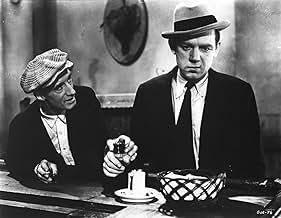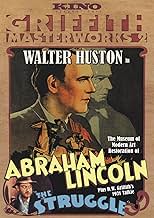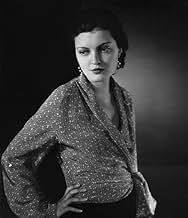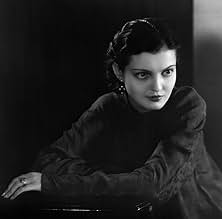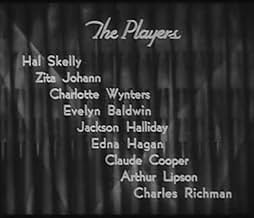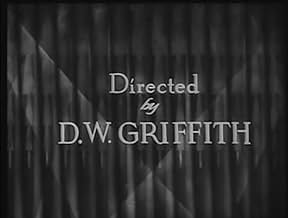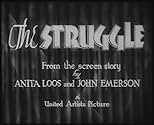Adicionar um enredo no seu idiomaA young couple's marriage is jeopardized by the husband's descent into alcoholism.A young couple's marriage is jeopardized by the husband's descent into alcoholism.A young couple's marriage is jeopardized by the husband's descent into alcoholism.
- Direção
- Roteiristas
- Artistas
Kate Bruce
- Granny
- (não creditado)
Tammany Young
- Barfly
- (não creditado)
- Direção
- Roteiristas
- Elenco e equipe completos
- Produção, bilheteria e muito mais no IMDbPro
Avaliações em destaque
By the time he made this film, Hollywood had D.W. Griffith right where they wanted him; a broken man. His studio was gone and he was selling out his UA shares--to make this film, I think. It's a shame that things went so wrong for him at this time, for it is evident in "The Struggle" that he was figuring out how to use this new sound gizmo. I was very impressed by his use of sound, almost Altman-like at times with overlapping dialogues. But, sadly, Hollywood had moved beyond DW, and didn't need or want him around anymore. This film is not the calibre of "Broken Blossoms" or "Intolerance", but it's a fine effort on a small scale from one of filmdom's greats.
1st watched 1/21/2010 – 5 out of 10 (Dir-D.W. Griffith): Interesting movie about the struggle against alcoholism that doesn't quite hit the mark due to it's lack of showing us how the battle can be won. The story is about a good-ole boy named Jimmy, played by Hal Skelly, who doesn't like to put the juice down until he meets his to-be wife. She persuades him to stop drinking if they get married and he does OK until after their first child is born and then he falls back into his same old ways. He loses his job, his family, and practically his life until he's rescued again by his wife. The movie shows how dependent family members are on the alcoholics and how difficult it is for the addicted to change his ways, but it doesn't make it clear how things can change. Things just kind of get better in the movie eventually and we know this doesn't happen in real life. A valiant effort by renowned silent movie director D.W. Griffith but there doesn't seem to be a clear focus on the purpose of the film and therefore it doesn't all quite jell. He drifts from an initial focus on the prohibition to eventually being a more personal movie but never quite aces either one. The quick ending kind of ruins what could have been an important piece of film about this disease instead it's just an OK film about this struggle.
I'm glad to see that the previous comments have been charitable. It's interesting that Griffith was filming the same type of story back in 1909 at Biograph. There are several characteristic Griffith touches in this film -- for instance, the tenderness of the wife when her husband first comes home drunk to her, and in the penultimate scene at his bedside. I'm sorry this picture never had a general release because it is well worth seeing. Chaplin made a silent film as late as 1931; perhaps Griffith should have taken a chance and done that with "The Struggle," because it may have worked better as a silent. References are made to the early days of Griffith's career in the opening scenes of the film; 1911 would seem to have been more remote to a 1931 audience than, perhaps, 1987 seems to us today. A fascinating film.
....when you consider some of the other movies for the year - "The Public Enemy", "Bad Girl", "The Maltese Falcon", "Waterloo Bridge", and that "The Struggle" was released in December of that year. Like the other reviewers, I was a bit hesitant to watch it - the last time I saw it was in the early 70s, at a film society and the only information I could find out about it then was in Anthony Slide's book "The Griffith Actresses" and he spent the article vigorously defending it against what critics had said when it was first released. They hated it and apparently there was even laughter in the first night audience. They called it old fashioned and criticized the banal dialogue - by 1931 Griffith was finished in Hollywood and critics were not going to view "The Struggle" with an unbiased eye. From the moralizing forward to the fact that there didn't seem much of a reason for Jimmy's descent into Hell, shows why it wasn't a success at the time. Sure, the depression was on but the public probably didn't want to be reminded of what, to many families (according to the forward) was a too real problem.
The movie took a sermonizing, finger shaking view. The prologue didn't seem to serve a purpose - except to show off the overlapping dialogue technique and to show that people were getting drunk (it was 1911) even before prohibition. 1923 - Zita Johann plays Florrie, a typical Griffith heroine, sweet, innocent and believing in her man - Jimmy (Hal Skelly), who, even before they marry, is considered the life of the party. The thing I found hard to swallow was that there was no huge crisis that happened for Jimmy to fall off the wagon. Of course, before his marriage he takes "the pledge" and they have several happy years, before a bar-tender's snide remark at his drink of choice - sarsaparilla, causes him to go on a bender. In another scene the thought of having to wear a lavender tie causes him to miss his sister's engagement for a night on the town. The best scene, in my opinion, is Hal Skelly's bout of the D.Ts - his was the best performance in the movie. I believe he could have developed into a great character actor, if he had lived. Zita Johann had been recruited from Broadway, where, along with Clark Gable, she had appeared in the play "Machinal", but in this movie, she looked very new and obviously wasn't a natural for the movies. (She only made a few, including "The Mummy" before she returned to the stage). Most of the performances seemed stiff and lacking in the direction that Griffith should have provided. Helen Mack made her debut as a "catty" girl at the engagement party and Evelyn Baldwin, who became Mrs. D.W. Griffith in 1936 played Jimmy's sister, Nan.
The movie took a sermonizing, finger shaking view. The prologue didn't seem to serve a purpose - except to show off the overlapping dialogue technique and to show that people were getting drunk (it was 1911) even before prohibition. 1923 - Zita Johann plays Florrie, a typical Griffith heroine, sweet, innocent and believing in her man - Jimmy (Hal Skelly), who, even before they marry, is considered the life of the party. The thing I found hard to swallow was that there was no huge crisis that happened for Jimmy to fall off the wagon. Of course, before his marriage he takes "the pledge" and they have several happy years, before a bar-tender's snide remark at his drink of choice - sarsaparilla, causes him to go on a bender. In another scene the thought of having to wear a lavender tie causes him to miss his sister's engagement for a night on the town. The best scene, in my opinion, is Hal Skelly's bout of the D.Ts - his was the best performance in the movie. I believe he could have developed into a great character actor, if he had lived. Zita Johann had been recruited from Broadway, where, along with Clark Gable, she had appeared in the play "Machinal", but in this movie, she looked very new and obviously wasn't a natural for the movies. (She only made a few, including "The Mummy" before she returned to the stage). Most of the performances seemed stiff and lacking in the direction that Griffith should have provided. Helen Mack made her debut as a "catty" girl at the engagement party and Evelyn Baldwin, who became Mrs. D.W. Griffith in 1936 played Jimmy's sister, Nan.
Griffith's title of this movie lives up to what he must have gone through to get the movie made. It's a story that he could've easily made in the midst of the silent era circa 1913. It moves like his Biograph shorts, just with sound. Zita Johann is so 'Alice Joyce-like' in her performance that is the sympathetic-understanding wife type. Why doesn't she just take the daughter and leave Hal Skelly one would ask?
The later parts of the film pick up steam as opposed to the earlier parts. A group of children taunt Kelly in the street after his descent into alcoholism and loss of his job. Griffith meant to show the kids as cruel but they are more cute than malevolent. They are dressed like they are readying for a Little Rascals shoot. If you're acquainted with Griffiths numerous Biograph shorts, especially the preachy ones making moral statements, this film shows his return to this genre.
The later parts of the film pick up steam as opposed to the earlier parts. A group of children taunt Kelly in the street after his descent into alcoholism and loss of his job. Griffith meant to show the kids as cruel but they are more cute than malevolent. They are dressed like they are readying for a Little Rascals shoot. If you're acquainted with Griffiths numerous Biograph shorts, especially the preachy ones making moral statements, this film shows his return to this genre.
Você sabia?
- CuriosidadesThis was the final feature-length film directed by D.W. Griffith.
Principais escolhas
Faça login para avaliar e ver a lista de recomendações personalizadas
Detalhes
- Data de lançamento
- País de origem
- Idioma
- Também conhecido como
- Ten Nights in a Bar Room
- Locações de filme
- Empresas de produção
- Consulte mais créditos da empresa na IMDbPro
- Tempo de duração1 hora 27 minutos
- Cor
- Proporção
- 1.20 : 1
Contribua para esta página
Sugerir uma alteração ou adicionar conteúdo ausente


